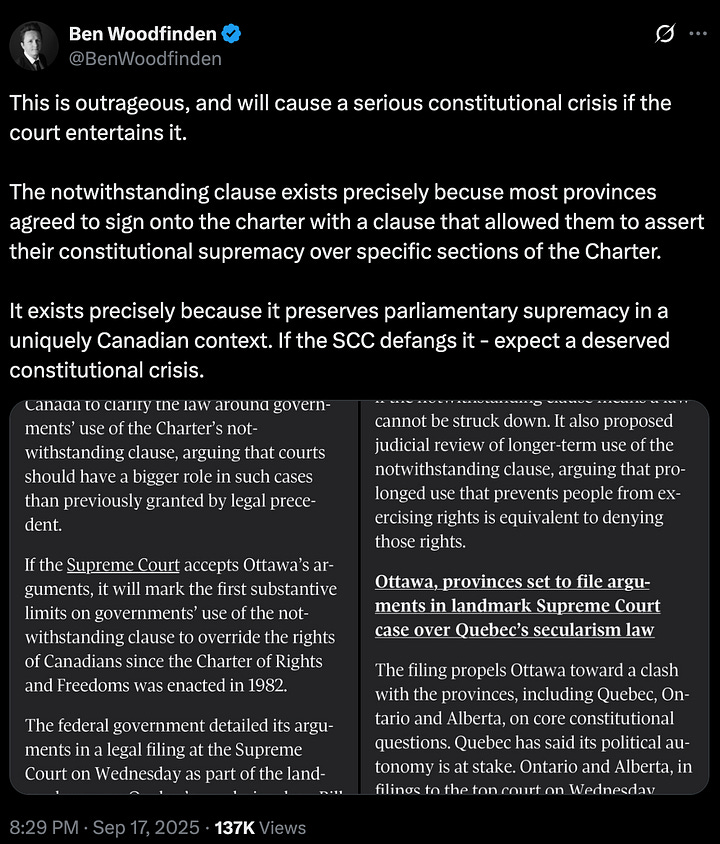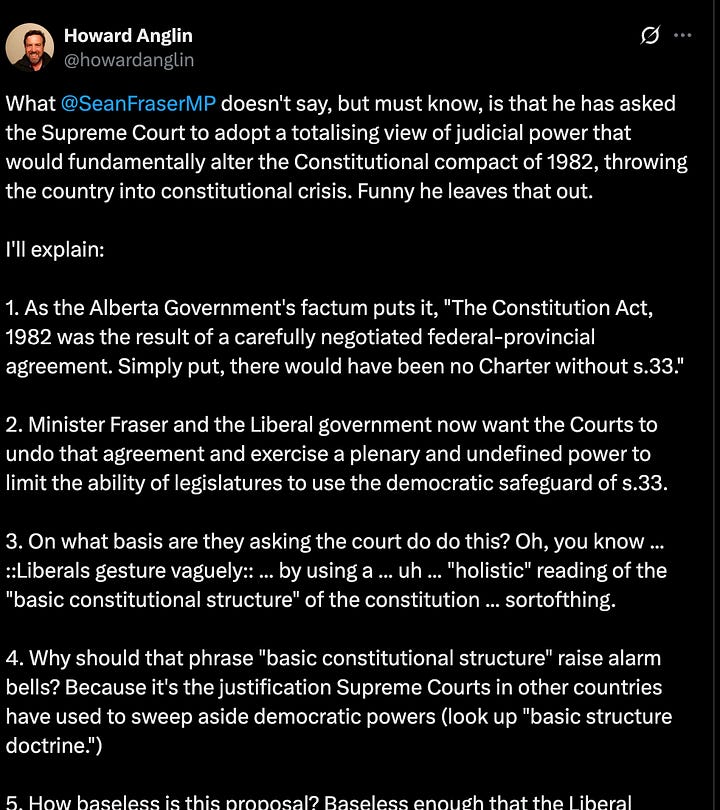No position on any basis
The feds say the opposite of what they think on rights
So far the debate on the federal government’s decision to intervene on Quebec’s Bill 21 at the Supreme Court is a reminder of why we should probably never talk about the constitution again.
Bill 21 (It’s been the law for six years, but we keep calling them Bills) is Quebec’s Act Respecting the Laicity of the State, which sounds more dignified than Act Ensuring Teachers Won’t Wear Headscarves. On the principle that Quebec has no state religion, it declares that state employees must display no sign of religious affiliation. To me, this wilfully confuses the state’s obligation to tolerate many religions with state intolerance of anyone’s religion, and I’ve never liked it. To accomplish this prima facie mangling of the Charter of Rights’ Section 2 freedom-of-religion guarantee, the law invokes the “notwithstanding” clause in S. 33 to say the restriction will hold despite what the Charter would normally prohibit.
This law has been around for six years. Throughout that time it’s been worth your life to find any federal party leader who’ll talk a straight line on it. In the generally disappointing 2019 Maclean’s debate, I tried to get the party leaders who showed up (everyone except Justin Trudeau) to express more than handwringing about Bill 21, without success.
That same year, Montreal Liberal MP Anthony Housefather wrote, “Prime Minister Justin Trudeau, Attorney General David Lametti and Heritage Minister Pablo Rodriguez have all been extremely clear in both official languages that we… strongly oppose any attempts to restrict people from wearing religious symbols in any job.”
This would very much depend on definitions of the word “strongly.”
As recently as January of this year, every candidate for the leadership of the federal Liberal party promised to keep doing whatever Trudeau was doing on the file. I think the biggest difference in federal politicians’ reaction to this Quebec law isn’t between Liberals and other parties, it’s between leaders and ordinary MPs: Many MPs from parties that aren’t the Bloc have been eloquent in their dislike for Bill 21, whereas leaders from all parties have been fast converts to the church of reticence.
Now the case is at the Supreme Court, after judges in the Quebec Superior Court and the Court of Appeal of Quebec both said the law is protected by Quebec’s invocation of the S. 33 “notwithstanding” clause. It’s speak-now-or-forever-hold-your-peace time, and the feds are speaking.
The case is a right donnybrook, with 13 appellants and more than 60 intervenors. Name a constitutional lawyer in this country; he or she has a piece of this trial. I mean, Allan Rock is on this case, as lead counsel for the Samara Centre for Democracy. Of course everyone’s interested: the case touches on minority-language rights, religious rights, the balance of the federation, plus every conceivable issue that future uses of S. 33 might hypothetically entail. Factums — the parties’ detailed legal arguments — are here.
Parties fall roughly into two camps: the Attorney General for Quebec, five other provincial governments, and several other organizations argue that Quebec is clear of the Charter guarantee of religious freedom because it made proper use of S. 33. The English Montreal School Board and many other groups, often defending minority rights, say the law’s restrictions are so sweeping that invoking S. 33 doesn’t extinguish the affected rights. At lower courts, so far Quebec has been winning.
The feds’ factum is here. It manages to fall into neither of the broad camps I just described. Is the ban on religious insignia in the public service legal or appropriate? Don’t ask Sean Fraser. “In accordance with his role as intervenor, the Attorney General of Canada takes no position, on any basis whatsoever, on the constitutional validity of the provisions of the Act respecting the laicity of the State,” the federal factum says.
This is claptrap. Dozens of other intervenors, in accordance with their roles as interveners, take clear positions on the constitutional validity of Bill 21, and Ottawa would not have violated any rule by doing the same. This government just didn’t want to.
The rest of the feds’ short factum makes three claims:
(1) That S. 33 can suspend only the rights listed under S. 2 and SS. 7-15 of the Charter;
(2) That repeated use of S. 33, which must be re-invoked every five years, would amount to extinguishing a right forever, so courts must “retain jurisdiction” to review a law each time S. 33 is re-invoked;
(3) That courts may declare a rights violation — even if a law’s use of S. 33 ensures the law will continue to operate even though it violates the stated right.
I’m gonna be straight with you, Substack, the main reason it took a while for me to comment on all of this was that I could barely believe the Attorney General of Canada had such modest ambitions. These read like study notes for an undergraduate quiz on the Charter.
Let’s take them in order. Point (1): Yes. Yes, that is what S. 33 says. In the case of Bill 21, the Superior Court judge struck down some parts because he thought it affected rights besides the rights in SS. 2 and 7-15, and the Appeals Court revived those parts because it disagreed. The Supremes might do one or the other, but they don’t need AG Canada to tell them what they’re allowed to do.
Point (2): Again, we’re pushing through an open door. If, at some point, somebody challenged a future re-invocation of S. 33, courts would be able to decide whether they accept the challenge, and the question of whether the nth use of S. 33 was one use too far would be something a court could consider. It’s not at all clear what we’ve learned here.
Point (3): Here, the feds are essentially saying they liked the Quebec Superior Court ruling better than the Appeals Court ruling, because Superior Court judge Marc-André Blanchard listed the rights he saw being violated before concluding that he could do nothing about most of them. The Appeals Court said it had no business making such a list, because S. 33 should essentially blind courts to what happens behind the curtain. (Judge Blanchard isn’t the Marc-André Blanchard who works in Mark Carney’s PMO. Red herring.)
It seems to me the Supremes could agree with everything AG Canada and its lead counsel, Guy Pratte, argue here without invalidating any part of Bill 21. Point (3) is, to me, the most annoying, because it amounts to the feds saying to the Supremes: We express no opinion on the substance of this law, but we’re going to need you to say what you think about it. Coming as it does after half a decade of Liberal self-congratulation for their courage on the matter, that’s a lot to swallow.
Note here that the Government of Canada is essentially arguing in court the opposite of what Liberal MPs and some cabinet ministers have said, many times, they believe. Is Bill 21 discriminatory? Is it bad law? Anthony Housefather said Liberals “strongly believe” it is. Dozens of lawyers for other organizations are not afraid to argue in court that it is. But in court Sean Fraser’s legal team will affect not to have an opinion on the matter.
Instead, they urgently want to remind the Court that the Constitution of Canada says what it says and that judges may think what they think. The good news is that, in considering the altogether more robust arguments from dozens of other participants in this case, the Supremes needn’t tarry long on these revelations.
I’d stop there, but I’d be wrong to ignore serious observers arguing that AG Canada’s intervention isn’t anodyne or trivial, but that it’s such a radical attack on the balance of federalism that it would throw us all into constitutional crisis. Say hello to Ben Woodfinden, who interrupted his PhD studies to work for Conservative leader Pierre Poilievre, and to Howard Anglin, who was Deputy Chief of Staff to then-PM Stephen Harper and Principal Secretary to Alberta’s then-premier Jason Kenney. Here’s Ben’s tweet, and Howard’s, with partial screenshots so you get the gist:


I admire both of these guys, and I don’t want to be glib here, and yet here it comes. I’m not sure how serious the constitutional crisis would be if the Government of Alberta were forbidden, in some instances and to some extent, from doing what it has never yet done, and specifically what it did not try to do when Howard Anglin was working for it, just as the federal government did not try to do it during the decade Anglin’s former boss was running that government. To be fair, Woodfinden and Anglin were soon joined in ecstatic combat by Brother Coyne, who never saw a nuclear option he didn’t want to nuke. If the other guy is shouting, it is hard to avoid the temptation to shout.
This is how constitutional obsessives operate. It’s been a while since constitutional obsession was the national pastime. I had hoped we could forget the instincts that drove it. For the information of young readers, the era of constitutional obsession lasted roughly from the 1980 Quebec referendum to the no-fun-at-all 2013 Senate Reference, and it had these characteristics. First, serious people believed no politics was serious except constitutional politics. Second, serious people took their own preferences to be sacred, and others’ preferences to be silly or wicked. This led to endless confrontations between adherents of provincial equality and advocates of a special historic role for Quebec, or people who liked to point out that Prince Edward Island has fewer people than Ontario. Third, constitutional obsession is characterized by near-instantaneous wild brinksmanship: when discussing obscure details of novel interpretations of stuff most people would never read as far as you have, it is deemed important to use words like “nuclear” or “crisis.”
I grew up when this sort of behaviour was almost universally held to be a condition of entry into serious conversation about Canadian politics. Constitutional obsession is to some extent a chronic condition: if you have ever exhibited its symptoms, you are prone to flare-ups at any point for the rest of your life. These things take on the characteristics of arguments about Bulls vs. Lakers, or Sonny Stitt vs. Sonny Rollins on Dizzy Gillespie’s album The Eternal Triangle. There is weight to the various arguments, but to some extent they’re not arguments, they’re social clubs. How quickly everyone forgets the issue at hand, which some politicians used to say was the tension between the right of a teacher to dress as she believes proper, and the purported right of her neighbour not to have to see her do that.



I didn't want this thing to be too long before I sent it out, but I feel bad that I didn't point to this public-opinion research from the Environics Institute. The post points out some surprising results, and then suggests reasonable explanations, but if it makes no other point than "Opinions on this stuff are not monolithic or eternal," that would be a great addition to the conversation. https://cdnsurveystuff.substack.com/p/what-if-section-33-becomes-an-issue
The Alberta position in this is substantially correct. No section 33, no Charter. It simply would have never been ratified by the provinces.
The notwithstanding clause is not an accident, it was a purposeful mechanism which ensures our elected leaders have the final say on legislation - NOT the judiciary.
Asking the courts to rule on whether this mechanism should be limited BY THE COURTS is ridiculous.
If the Liberals actually want to amend the charter, there is a clear mechanism for that too.
Simply gain express agreement from enough provinces, and Bob is your uncle.